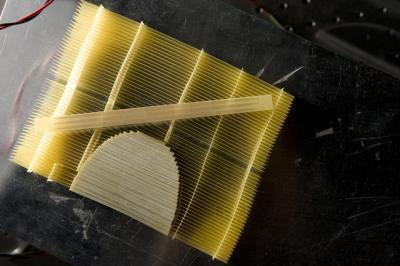Duke University engineers have created a new generation of lens that could greatly improve the capabilities of telecommunications or radar systems to provide a wide field of view and greater detail.

A close-up view of the new lens. (Credit: Duke University Photography)
But the lens they fashioned doesn't look anything like a lens. While traditional lenses are made of clear substances -- like glass or plastic -- with highly polished surfaces, the new lens looks more like a miniature set of tan Venetian blinds. Yet its ability to focus the direction of electromagnetic rays passing through it dramatically surpasses that of a conventional lens, the engineers say.
The latest advance was made possible by the ability to fabricate exotic composite materials known as metamaterials. The metamaterial in these experiments is not so much a single substance, but the entire man-made structure which can be engineered to exhibit properties not readily found in nature.
The prototype lens, which measures four inches by five inches and less than an inch high, is made up of more than 1,000 individual pieces of the same fiberglass material used in circuit boards and is etched with copper. It is the precise arrangement of these pieces in parallel rows, that directs the rays as they pass through.
"For hundreds of years, lens makers have ground the surfaces of a uniform material in such a way as to sculpt the rays as they pass through the surfaces," said Nathan Kundtz, post-doctoral associate in electrical and computer engineering at Duke's Pratt School of Engineering. "While these lenses can focus rays extremely efficiently, they have limitations based on what happens to the rays as they pass through the volume of the lens.
"Instead of using the surfaces of the lens to control rays, we studied altering the material between the surfaces," Kundtz said. "If you can control the volume, or bulk, of the lens, you gain much more freedom and control to design a lens to meet specific needs."
The results of his experiments, which were conducted in the laboratory of senior researcher David R. Smith, the William Bevan Professor of Electrical and Computer Engineering, appeared as an advanced online publication of the journal Nature Materials. This is the first demonstration of what was thought to be theoretically possible.
Recognizing the limitations of traditional lenses, scientists have long been investigating other options, including those known as gradient index (GRIN) lenses. These are typically clear spheres, and while they have advantages over traditional lenses, they are difficult to fabricate and the focus point is spherical. Additionally, because most sensing systems are oriented in two dimensions, the spherical image doesn't always translate clearly on a flat surface.
The new lens, however, has a wide angle of view, almost 180 degrees, and because its focal point is flat, it can be used with standard imaging technologies. The latest experiments were conducted with microwaves, and the researchers say it is theoretically possible to design lenses for wider frequencies.
"We've come up with what is in essence GRIN on steroids," said Smith, whose team used similar metamaterials to create one of the first "cloaking" devices in 2006. "This first in a new class of lenses offers tantalizing possibilities and opens a whole new application for metamaterials.
"While these experiments were conducted in two dimensions, the design should provide a good initial step in developing a three-dimensional lens," Smith said. "The properties of the metamaterials we used should also make it possible to use infrared and optical frequencies."
The researchers say a single metamaterial lens could replace traditional optical systems requiring vast arrays of lenses and provide clearer images. They could also be used in large-scale systems such as radar arrays to better direct beams, a task not possible for traditional lenses, which would need to be too large to be practical.
The research was supported by the Army Research Office's Multiple University Research Initiative (MURI).
(责任编辑:董静)